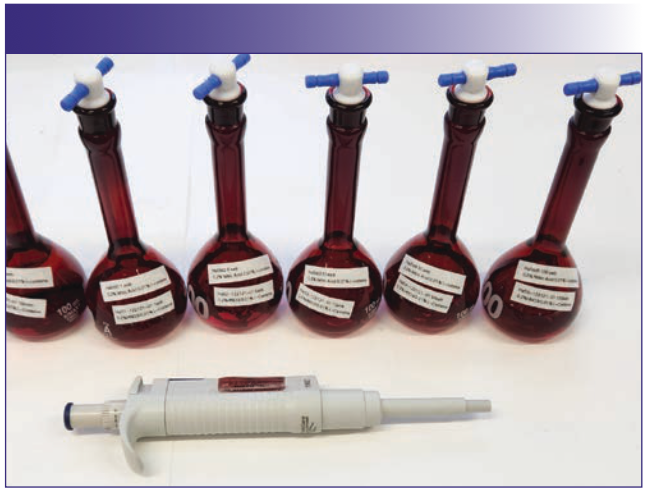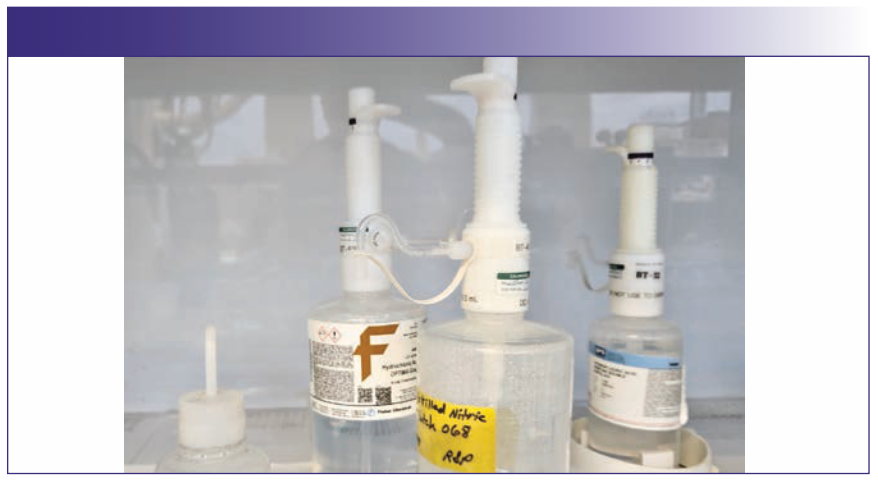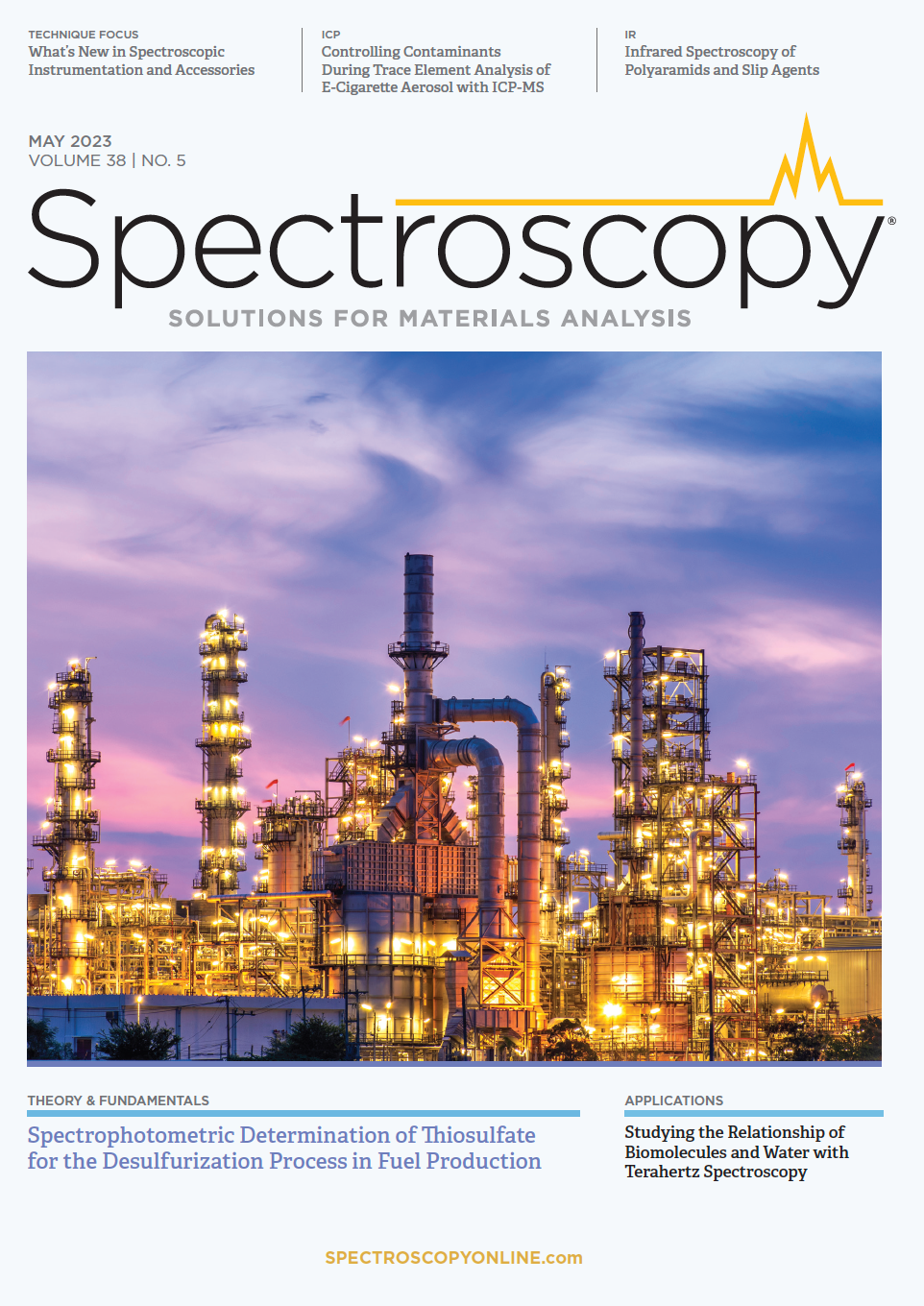Contamination Control During Sample Preparation for Trace Element Analysis of Electronic Cigarette Aerosol with Inductively Coupled Plasma-Mass Spectrometry, Part 1
In this two-part article, the authors take a look at the major factors affecting background contamination in inductively coupled plasma-mass spectrometry (ICP-MS), particularly when measuring ultratrace elements in specialty applications such as aerosol matrices from electronic cigarettes and electronic nicotine delivery systems (ENDS). In order to obtain meaningful data, the analyst must understand and address the magnitude and variability of environmental contamination by ubiquitous trace metals during the sample preparation procedure. The impact of these contaminants on the procedural blank and the associated impact on the accuracy and precision of sample results can unfortunately lead to false positive results.
Liquid introduction with flow injection is the most widely used sample introduction method for inductively coupled plasma-mass spectrometry (ICP-MS). Nevertheless, background contamination issues are problematic for determinating trace or ultratrace analyte concentrations that are commonly investigated. This is particularly important in specialty applications such as aerosol matrices from electronic cigarettes (also known as vapes, electronic nicotine delivery systems [ENDS]). To obtain meaningful data, the analyst must understand and address the magnitude and variability of environmental contamination by ubiquitous trace metals during sample preparation for trace analyses. The impact of these contaminants on the procedural blank and the associated impact on the accuracy and precision of sample results can lead to false positive results. Part 1 of this tutorial addresses address how environmental contamination may be minimized by using good personal analytical practices, avoidance of glass and low purity quartz during sample collection and preparation, and choices of high purity solvents during sample collection and preparation.
Part 2 will discuss the use of high purity polymer materials during sample collection and preparation, elemental carryover during sample preparation, and how the inorganic analyst can avoid approaches and procedures that may cause unforeseen problems.
Preparation for Analysis of Organic Substances Versus Inorganic Substances
Sample preparation and analysis of samples for many organic substances may be based on the assumption that the organic analytes are not environmentally ubiquitous. For example, if an analyst is required to analyze nicotine in tobacco, tobacco smoke, liquids, or aerosols from ENDS, the analyst may reasonably assume that extractable nicotine concentrations on glass surfaces of clean beakers, flasks, impingers, filter materials, pipet tips, glass or polymer sample vials, and other ancillary materials are negligible. In such cases, any analytical signal detected in procedural blanks is likely due to poorly cleaned glassware, the presence of other compounds with the same nominal mass, or from instrumental electronic noise. This assumption, however, is not valid for sample preparation for analysis of trace metals in tobacco, tobacco smoke, liquids, or aerosols from ENDS with inductively coupled plasma-optical emission spectrometry (ICP-OES) or ICP-MS. Metals are ubiquitous in many, if not most, commonly used laboratory set-up and supplies, including (but not limited to) glassware, hood surfaces, dust particles, filter paper, tubing, and pipette tips. Different ancillary materials and a different skillset are required for sample preparation for analysis of trace metals in any matrix by ICP-OES or ICP-MS.
Factors That Interfere with Accuracy in Analyses for Inorganic Substances
The relative ease or difficulty of a given analysis depends on several factors, including concentration of the analyte relative to the sensitivity of the analytical instrumentation, the chemistry of the analyte, the matrix, isotopic interferences from other elements that have the same mass as the analyte (1), polyatomic ionic interferences formed in the plasma during the analysis that have the same mass as the analyte (2), and the potential for environmental contamination by extractable metals that are present to various degrees on all surfaces and most materials.
The following suggestions can be an effective means to reduce the background contamination issues, make a difference in levels of contamination associated with environmentally ubiquitous metals, and yield lower procedural blanks and method limits of detection (LOD), as well as false positive results:
- Use powder-free gloves, nitrile if possible. Powder particles can contaminate samples.
- Do not pick up sample tubes with a fingertip inside the tube opening.
- Avoid contact of fingers or gloves with surfaces near the opening or inside the cap of any sample tube or solvent container.
- Use pipets with polypropylene or fluoropolymer pipet tips, never glass pipets.
- Use pipets that do not have external stainless steel tip ejectors (Figure 1; all figure images are CDC sourced). It is easy to touch a drop of liquid with the tip ejector and contaminate a sample with iron, chromium, nickel, and other metals. If pipets have external steel tip ejectors, it is advisable to remove the tip ejectors and remove the tips manually after use in sample preparation.
- Never turn a pipet sideways while liquid is in the tip. Acid will corrode the pipet piston and degrade it, resulting in contaminated samples.
- If a pipet tip touches skin or a laboratory surface, assume that it is contaminated. Learning not to lean back against a countertop in a laboratory also prevents contact and contamination of tips that may have been left protruding over the side of the countertop by a fellow laboratory worker who did not want the tip to touch the countertop surface.
- Do not purchase acid in glass containers. Ultrahigh purity acids for analysis of metals are double distilled from fluoropolymer or high purity quartz stills and sold in perfluoroalkoxy (PFA) or fluorinated ethylene propylene (FEP) fluoropolymer bottles (Figure 2). Less expensive intermediate purity acids are available in polyethylene or polypropylene containers. Several purity grades can be obtained in polyethylene or polypropylene containers that are still higher purity than acids from glass bottles. The acids may be further purified by distillation in PFA or high purity quartz stills sold by some vendors. Depending on acid consumption in a laboratory, these stills can pay for themselves with savings on ultrahigh purity acids in approximately a year.
- If using bottle top acid dispensers, avoid glass entirely. Use empty PFA, FEP, or polypropylene containers that have been well rinsed with dilute ultrahigh purity acid. Use dispensers with fluoropolymer only exposed to the path of liquid flow (Figure 2). A dispenser that has glass parts or that has a platinum coated valve ball is unsuitable for dispensing acids for trace metals analysis. For example, one of our team members obtained a dispenser that had an “inert” platinum coated valve ball in an otherwise all-fluoropolymer liquid path. This dispenser ruined several of our analyses before we realized that multiple metal impurities were leaching into acid from the platinum coated valve ball. The first few liquid pumps were low in metals concentrations, followed by metals concentrations that reached a peak as the acid that was in contact with the platinum reached the dispenser outlet, then declined again as subsequent pumps rinsed the metals out.
- If the laboratory has high airborne particulate, use a plastic autosampler cover. This is a good idea even if the air particulate is not very high. Covers may be purchased with or without high efficiency particulate air (HEPA) filtered air units that blow filtered air over open sample containers.
- Unless it is the only way to avoid inhalation of acid vapors, use a hood for diluting or transferring concentrated acids, but do not leave samples in a hood unless it has little or no corrosion and laminar flow with HEPA filtered air. If laboratory air has high particulate levels, a standard hood protects the analyst, but pulls contaminated laboratory air over open sample or solvent containers faster than air outside the hood. Polypropylene hoods with HEPA or ultra-low particulate air (ULPA) filtered air are available (Figure 2), but they require sufficient dedicated air flow. If the analyst works with hydrofluoric acid, a hood absolutely must be used for safety.
FIGURE 1: Pipet that is manufactured with plastic, not steel. Pipet tip ejector and glass volumetric flasks are used for mercury standards only. The use of glass containers for metals other than mercury is a poor analytical practice.

FIGURE 2: PFA ultra-high purity acid bottles that have been repurposed as high purity acid dispenser bottles. The bottletop dispensers also have 100% PFA liquid path. The vessels are inside a polypropylene laminar flow hood to prevent sample contamination during preparation.

Choice of Materials Used for Sample Collection, Preparation, and Analysis
An analyst must consider and choose appropriate types of ancillary materials that will be used for transfer, containment, and digestion for dissolution of metals and elimination of organic substances before developing an analytical method for analysis of trace metals. As previously discussed, glass containers and transfer devices are appropriate choices for preparation of samples for the analysis of organic substances. Even though some glass microparticles and trace inorganic substances from glass may be extracted into the standard or sample solution, they are often eliminated during further organic sample preparation steps, or not detected during common chromatographic or mass spectrometric analyses. However, the use of glassware is a very poor analytical practice for analysis of trace metals with very few exceptions.
Mercury is a rare exception to the rule of avoiding glass for analysis of trace metals. Mercury compounds may adhere to glass silicate surfaces on the basis of polar attractions, but mercury is a Pearson soft acid cation metal (3,4) and is not strongly coordinated to surface oxygen atoms of glass silicate containers in the presence of a polar or acidic solvent. Mercury halides are readily extracted from some aqueous solvents into polar organic solvents in glass vessels (5). Because mercury is not strongly coordinated to silicates, it is usually found at very low concentrations in glass. Thus, glass tends to have very low mercury concentrations. Therefore, mercury standards may be prepared in glass volumetric flasks for analysis with a direct mercury analyzer (6,7). Low ng/L concentration mercury standards prepared in 0.2% v/v ultrapure nitric acid and 0.01% w/v high metals purity L-cysteine were stable when kept refrigerated in glass flasks for more than a year (Figure 1). Refrigeration was used between analyses to slow cysteine thiol oxidation beyond the disulfide form of sulfur that can coordinate soft acid cation metals like mercury to prolong the stability of mercury in oxidized form in solution.
Mercury is an exception to the common good analytical practice of avoiding sample and solvent exposure to glass when it is the lone analyte with a direct mercury analyzer. If mercury is not the lone analyte, the general good inorganic analytical practice of avoiding glass always applies, because other metal contaminants are likely to be extracted from glass by acidic solvents. Avoiding glass during trace metals analyses has been recognized as a good inorganic analytical practice for decades. We have found it necessary to briefly review the chemistry of glass related to metals analysis since the development of ENDS devices, and availability of grant funding to study their emissions has attracted many scientists with limited experience in the analysis of metals. In some states, regulatory requirements for aerosol de- vices include the analysis of toxic metals in liquids and aerosols of some devices. This has increased the demand for inorganic analytical chemists in commercial compliance laboratories as well, resulting in a shortage of competent inorganic analytical chemists. Often this demand is filled with analysts who may have experience performing analyses of organic substances but may benefit from a review of good inorganic analytical practices that differ from good organic analytical practices.
Avoidance of Glass for Inorganic Sample Collection, Preparation, and Analysis
Murphy (8) discussed the need to avoid glass during sample preparation for accuracy in trace element analyses in 1976, before greater sensitivity made possible by instrumentation developments since that time made lower contaminant concentrations even more apparent. In 1984, Knapp stated, “Glass is usually not suitable...” for trace element determinations (9). In 1996, Dulski discussed the avoidance of glass during analysis of metals (10). The inorganic analytical chemist needs to be aware of why these highly experienced chemists discussed the need to avoid glass during sample preparation and inorganic analysis.
The first reason is the mobile nature of ions in glass. Glass is manufactured from substances with low elemental purity, so glass is not a pure silicate substance. Thin glass membrane electrode glass is known to contain other impurities but is manufactured with high concentrations of some ions, such as sodium from soda ash. Whether the analyte intended to be measured is hydronium ion with a pH meter electrode or a specific metal with a selective ion electrode, the thin glass membrane analytical design is based on different potentials for two or more different hydronium or metal ions to migrate to and from the glass membrane silicate matrix (11). There are numerous selective glass electrode designs based on different glass membrane potential combinations for different metal ions, but the application of the pH meter demonstrates the migration of acid hydronium ions into the glass membrane in exchange for metal ions from glass silicate matrix. This is one reason that acidic samples are contaminated by metal impurities from glass.
If pure water were a sufficiently strong solvent for all metal ions, inorganic analytical chemistry would be much easier. However, most metals other than alkali metals require acids to prevent hydrolysis of the metal ions to the respective oxides or hydroxides, nearly all of which are insoluble in water at neutral pH (4). To illustrate problems with the use of acids in glass flasks as impingers for collection of aerosols for metals, four borosilicate glass laboratory flasks were rigorously precleaned overnight with ultrapure acid, and shaken with 10% v/v ultrapure concentrated nitric acid and 1% v/v hydrochloric acid that was discarded before five hour leaching periods in the same acid mix, corresponding to a procedure for trapping metals for aerosol analysis over a period of 5 d. Although five analyses in 5 d is insufficient for establishing a legitimate method limit of detection, the day-to-day variability and ranges of concentrations observed from leaching chromium, nickel, copper, zinc, tin, and lead were higher than sample results reported in the literature, with the exception of copper at elevated concentrations in some aerosols from a few devices (12). It is apparent that the use of glass vessels for sample collection for smoke or aerosol analysis will result in samples contaminated by metals leached from glass by acid, and produce unreliable results.
Before more advanced sample preparation devices became available, automated pipettors with glass barrels were used for dilution of samples such as urine into acids containing internal standard metal ions for analysis. The sample and internal standard solution uptake and delivery tubing were made from ultrahigh metals purity fluoropolymers such as PFA. However, the syringe barrels were made of glass and later from low purity quartz. When an analytical chemist began the workday, the syringe barrels were set to maximum volume and 10 to 20 syringe barrel volumes of dilute ultrapure acid solution were passed through the barrels to rinse out the metal ion contaminants that had accumulated from the glass barrels. When the analyst monitored the selected ions, they decreased with each barrel rinse. The acid-extracted metals were significant relative to metal concentrations in urine samples until the syringe barrels were well rinsed with acid, thus necessitating the daily preanalytical acid rinses of the glass barrels. Although the metal concentrations decreased by about half over a period of six months to a year, they never completely diminished. To make matters worse, the kinetics of ion exchange from the glass silicate matrix to the acid were fast. The analyst had to have all samples ready for dilution and continuously dilute one sample after another without stopping. If the sample preparation was stopped for even 5 min, the analyst would see an increase in metal concentrations that came from the glass barrels and contaminated the samples. Even after a 5 min delay, the analyst had to again rinse the barrel contents with the acid solution before resuming sample preparation. One manufacturer was aware of this problem and manufactured some quartz barrels for trial purposes. Unfortunately, the manufacturer used less expensive low purity quartz to manufacture the barrels rather than high purity fused silica quartz. The low purity quartz barrels had lower concentrations of metals leaching from the quartz silica matrix than from glass barrels over time, but the metals concentrations were still significant relative to metals concentrations in urine samples. Over a six-month period, the metals leached from low purity quartz barrels also diminished to concentrations lower than metals concentrations from glass barrels after six months, but the metals concentrations were still sufficiently high that the barrels still had to be daily rinsed out with acid prior to use and after any sample preparation delay. After years of intentional leaching from glass syringe barrels, leaching of metals by acids was still observed. This illustrates that glass cannot be “cleaned” sufficiently for use in trace metals analysis. The avoidance of contact of acidic solutions with glass is not limited to inorganic acids but applies to organic acids as well (13).
Glass fiber filters are commonly used for trapping mainstream smoke particulate for analyses of organic substances. These filters have high acid leachable metals concentrations and are inappropriate for aerosol sample collection from ENDS devices and from mainstream smoke for metals analyses. Low purity quartz filters (14) also released unacceptably high metal concentrations unless subjected to extensive soaking and elimination of fine particles with multiple hot acid rinses. Even after extensive soaking in dilute ultrahigh purity acids, only cadmium, lead, and thallium could be observed in mainstream smoke at concentrations sufficiently above the acid extractable metals backgrounds that remained in the “precleaned” quartz filters (14). Many metal ion concentrations are lower in ENDS aerosols than in mainstream smoke since no combustion occurs; and because ENDS devices are not constructed from some toxic metals and metalloids that are commonly present in tobacco, such as cobalt, arsenic, cadmium, and mercury. The metals concentrations obtained from using dilute acid to extract metals from ENDS aerosols trapped with low purity quartz fiber filters were too high and too variable from sheet to sheet of quartz filter material for use as ENDS aerosol traps (15). Metals that are used in manufacture of ENDS devices are often below sensitive analytical method limits of detection in liquids and aerosols from newly manufactured devices (16), but the metals become more elevated with age and use of the devices due to corrosion (17). Since most mainstream smoke metals concentrations and ENDS aerosol metals concentrations after device corrosion remain at trace or ultratrace levels, glass or low purity quartz fiber filters contribute significantly to aerosol background levels because of metals leached by acid from the glass or low purity quartz filters. Thus, such filter materials are not suitable for use as mainstream smoke and ENDS aerosol sample collection or preparation materials. Extraction of metals from glass is not limited to acidic solutions. A group affili- ated with Schott AG recently published a white paper on delamination of pharma- ceutical grade glass vials in basic solution (18). They discussed their work to produce glass vials that are more resistant to delamination, as well as earlier work on delamination of glasses of various compositions in alkaline solution. Delamination of glass is not unexpected, since silicates are more soluble in alkaline solution, permitting small flakes of glass (along with metals in the glass silicate matrix) to become liberated from glass surfaces as the silicate is dissolved. Significant solubilization of molded glass component surface elements was also determined when vials were stored containing neutral aqueous 15% w/v KCl solutions or other alkali metal salts (19). For the inorganic analytical chemist, this data on glass and metal contaminants in acidic, basic, and neutral high ionic strength solutions confirm that complete avoidance of the use of glass flasks, impingers, watch glasses, sample tubes, vials, glass fiber filters, and other ancillary glass materials is good inorganic analytical practice for avoiding sample contamination from metals in glass.
Summary
In Part 1 of this article, we have discussed good sample handling practices that will help minimize sample contamination during preparation for inorganic analyses. We reviewed the background and gave specific examples of sample contamination caused using glass and low purity quartz during sample collection and preparation.
In our next column, we will discuss the use of ancillary polymer and fluoropolymer materials that may be obtained with very low acid-leachable metals and that may be further cleaned for use in inorganic sample collection and preparation.
Disclaimer
The findings and conclusions in this report are those of the authors and do not necessarily represent the views of the Centers for Disease Control and Prevention.
References
(1) Neubauer, K. Reducing the Effects of Interferences in Quadrupole ICP-MS. Spectroscopy 2010, 25 (11), 30–36.
(2) May, T. W.; Wiedmeyer, R. H. A Table of Polyatomic Interferences in ICP-MS. At. Spectrosc. 1998, 19 (5), 150–155 DOI: 10.46770/AS.1998.05.002
(3) Wulfsberg, G. Inorganic Chemistry; University Science Books, 2000, 191–228.
(4) Pappas, R. S. Sample Preparation Problem Solving for Inductively Coupled Plasma-Mass Spectrometry with Liquid Introduction Systems I. Solubility, Chelation, and Memory Effects. Spectroscopy 2012, 27 (5), 20–31.
(5) Tandon, S. N.; Gupta, C. B. Liquid-Liquid Extraction Behaviour of Mercury (II) as Chloride. Talanta 1971, 18, 109–112. DOI: 10.1016/0039- 9140(71)80013-9
(6) Fresquez, M. R.; Gonzalez-Jimenez, N.; Gray, N.; Watson, C. W.; Pappas, R. S. High Throughput Determination of Mercury in Tobacco and Mainstream Smoke from Little Cigars. J. Anal. Toxicol. 2015, 39, 545–550. DOI: 10.1093/jat/bkv069
(7) Fresquez, M. R.; Pappas, R. S.; Watson, C. H. Establishment of Toxic Metal Reference Range in Tobacco from U.S. Cigarettes. J. Anal. Toxicol. 2013, 37, 298–304. DOI: 10.1093/jat/bkt021
(8) Murphy, T. J. Accuracy in Trace Analysis: Sampling, Sample Handling, Analysis. Volume I, Publication 422; National Bureau of Standards, 1976, 530–533.
(9) Knapp, G. Decomposition Methods in Elemental Trace Analysis. Trends Anal. Chem. 1984, 3, 182–185. DOI: 10.1016/0165-9936(84)87011-9
(10) Dulski, T. R. A Manual for the Chemical Analysis of Metals; ASTM International 1996, 15.
(11) Wenzel, T. Ion-Selective Electrodes. Analytical Sciences Library, Electrochemical Analytical Chemical Methods, 2023, 7.1. https://chem.libretexts.org/Bookshelves/Analytical_Chemistry/Supplemental_Modules_(Analytical_Chemistry)/Analytical_Sciences_Digital_Library/In_Class_Activities/Electrochemical_Methods_of_Analysis/02_Text/7%3A_Electrochemical_Analytical_Methods/7.1%3A_Ion-Selective_Electrodes#:~:text=The%20glass%20used%20in%20a%20pH%20electrode%20contains,distance%20into%20the%20glass%20and%20displace%20 sodium%20ions
(12) Ahmed, A, A.; Youssof, I. M. Attack on Soda-Lime-Silica Glass Bottles by Acetic, Citric, and Oxalic Acids. Glass Sci. Technol. 1997, 70 (3), 76–85.
(13) Pappas, R. S. Measurement of Elemental Constituents of Cannabis Vaping Liquids and Aerosols with ICP-MS. In Measuring Heavy Metal Contaminants in Cannabis and Hemp; CRC Press, 2020, 289–304.
(14) Pappas, R. S.; Polzin, G. M.; Zhang, L.; Watson, C. H.; Paschal, D. C.; Ashley, D. L. Cadmium, Lead, and Thallium in Mainstream Tobacco Smoke Particulate. Food Chem. Toxicol. 2006, 44 (5), 714–723. DOI: 10.1016/j.fct.2005.10.004
(15) Lisko, J. G.; Hearn, B.; Pappas, R. S.; Stanfill, S.; Tyx, R.; Keong, L., et al. “Factors to Consider when Analyzing Electronic Cigarettes: Challenges and Solutions.” Society for Research on Nicotine and Tobacco Annual Meeting 2018, POS4–13. https://cdn.ymaws.com/www.srnt.org/resource/resmgr/conferences/2018_annual_meeting/65388_srnt_2018_abstract_fin.pdf
(16) Gray, N.; Halstead, M.; Valentin-Blasini, L.; Watson, C.; Pappas, R. S. Toxic Metals in Liquid and Aerosol from Pod-Type Electronic Cigarettes. J. Anal. Toxicol. 2021, 45 (4), 337–347. DOI: 10.1093/jat/bkaa185
(17) Halstead, M.; Gray, N.; Gonzalez-Jimenez, N.; Fresquez, M.; Valentin-Blasini, L.; Watson, C.; Pappas, R. S. Analysis of Toxic Metals in Electronic Cigarette Aerosols Using a Novel Trap Design. J. Anal. Toxicol. 2020, 44, 149–155. DOI: 10.1093/jat/bkz078
(18) Ennis, R. D.; Pritchard, R.; Nakamura, C.; Coulon, M.; Yang, T.; Visor, G. C.; Lee, W. A. Glass Vials for Small Volume Parenterals: Influence of Drug and Manufacturing Processes on Glass Delamination. Pharm. Dev. Technol. 2001, 6 (3), 393–405. DOI: 10.1081/pdt-100002248
(19) Haines, D.; Gober-Mangan, E.; Klause, M.; Rothhaar, U. Comparative Predictive Glass Delamination Study. Pharm. Ind. 2022, 84 (8), 1001–1012.
ABOUT THE CO-AUTHORS
R. Steven Pappas is a research chemist and inorganic analytical Team Lead in the Tobacco and Volatiles Branch of the Division of Laboratory Sciences at the National Center for Environmental Health, U.S. Centers for Disease Control and Prevention, in Atlanta, Georgia. Direct correspondence to: RPappas@cdc.gov ●

Naudia Gray is an inorganic analytical chemist who works for the Tobacco and Volatiles Branch of the Division of Laboratory Sciences at the National Center for Environmental Health, U.S. Centers for Disease Control and Prevention, in Atlanta, Georgia.

ABOUT THE EDITOR
Robert Thomas, the editor of the “Atomic Perspectives” column, is the principal of Scientific Solutions, a consulting company that serves the educational and writing needs of the trace element analysis user community. Rob has worked in the field of atomic spectroscopy and mass spectrometry for more than 45 years, including 24 years for a manufacturer of atomic spectroscopic instrumentation. He has authored more than 100 scientific publications, including a 15-part tutorial series, “A Beginners Guide to ICP-MS.” In addition, he has authored five textbooks on the fundamentals and applications of ICP-MS. His most recent book, a paperback edition of Measuring Heavy Metal Contaminants in Cannabis and Hemp, was published in December, 2021. He is currently working on the 4th edition of his Practical Guide to ICP-MS: A Tutorial for Beginners textbook, which should be published in July, 2023. Rob has an advanced degree in analytical chemistry from the University of Wales, UK, and is a Fellow of the Royal Society of Chemistry (FRSC) and a Chartered Chemist (CChem). Direct correspondence to SpectroscopyEdit@mmhgroup.com ●


Atomic Perspectives: Highlights from Recent Columns
March 3rd 2025“Atomic Perspectives,” provides tutorials and updates on new analytical atomic spectroscopy techniques in a broad range of applications, including environmental analysis, food and beverage analysis, and space exploration, to name a few. Here, we present a compilation of some of the most popular columns.